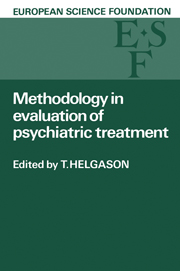 Methodology in Evaluation of Psychiatric Treatment
Methodology in Evaluation of Psychiatric Treatment Book contents
- Frontmatter
- Contents
- Participants
- Foreword
- Preface
- INTRODUCTION
- I METHODS OF CLASSIFICATION
- II EVALUATION CRITERIA
- III RATING METHODS IN EVALUATION OF TREATMENT
- TheAMP Rating Methods
- The Comprehensive Psychopathological Rating Scale (CPRS)
- The Use of Rating Scales for Affective Disorders
- Self-Rating Scales in the Evaluation of Psychiatric Treatment
- Methods for Measuring Social Adjustment
- IV OTHER QUANTITATIVE METHODS OFEVALUATION OF TREATMENT
- V ETHICALAND PRACTICAL PROBLEMS
- Index
The Comprehensive Psychopathological Rating Scale (CPRS)
from III - RATING METHODS IN EVALUATION OF TREATMENT
- Frontmatter
- Contents
- Participants
- Foreword
- Preface
- INTRODUCTION
- I METHODS OF CLASSIFICATION
- II EVALUATION CRITERIA
- III RATING METHODS IN EVALUATION OF TREATMENT
- TheAMP Rating Methods
- The Comprehensive Psychopathological Rating Scale (CPRS)
- The Use of Rating Scales for Affective Disorders
- Self-Rating Scales in the Evaluation of Psychiatric Treatment
- Methods for Measuring Social Adjustment
- IV OTHER QUANTITATIVE METHODS OFEVALUATION OF TREATMENT
- V ETHICALAND PRACTICAL PROBLEMS
- Index
Summary
The Swedish Medical Research Council supports improvement of research methodology interale by setting up ad hoc ‘planning groups’. In 1971 such a group comprising 15 psychiatrists, psychologists and clinical pharmacologists was formed and given the task of studying problems concerning the evaluation of change in psychiatric symptomatology with treatment. Jan-Otto Ottosson, M.D. and professor of psychiatry at the University of Gothenburg, was the chairman and leader of the group. The main interest was soon centred on the use of rating scales. Inquiries to psychiatric departments and drug companies in Scandinavia revealed that a great number of different scales were used, but also that none of them could be recommended for common use. For that reason the group decided that a new rating scale should be developed and a working team was formed. It consisted of three psychiatrists (M. Asberg, C. Perris and G. Sedvall) and one psychologist (D. Schalling). Later on, the English psychiatrist S.A. Montgomery was added to the group. An English version of the ‘Comprehensive Psychopathological Rating Scale (CPRS)’ was published in 1978 by Asberg et ale See also Asberg & Schalling (1979).
General problems of rating are discussed in the introductory paper (Cronholm & Daly). It may be added that rating essentially is a systematization of what we are doing in all clinical evaluation, even if it implies quantifying and measuring what may seem too subjective, too subtle and too elusive for any measurement to be possible. It is easily forgotten that any clinical statement about the severity of a disorder and about improvement or deterioration is essentially some sort of quantification.
From the very beginning it was agreed that the new scale should be developed with the explicit purpose of being useful for measuring change in severity of a mental disorder during treatment. It should be of use for comparison between an active drug and placebo, or between two or more different drugs. This means that the items included should be sensitive to change in the disorder studied. On the other hand it was not necessary that they had any diagnostic specificity - the scale was not to be used as a diagnostic instrument. As a matter of fact, very few symptoms in themselves are really specific to any particular psychiatric disorder. Many symptoms are quite unspecific and appear as an integral part in most psychiatric syndromes.
- Type
- Chapter
- Information
- Methodology in Evaluation of Psychiatric TreatmentProceedings of a Workshop Held in Vienna 10–13 June 1981, pp. 163 - 170Publisher: Cambridge University PressPrint publication year: 1983


